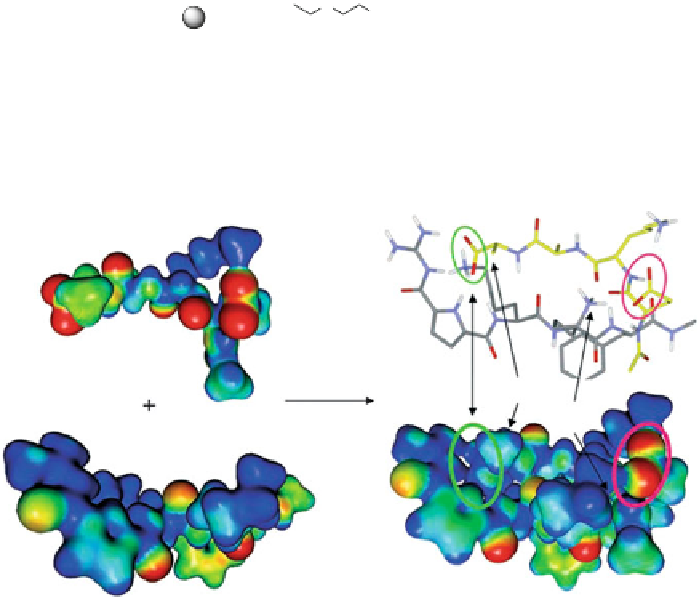Biomedical Engineering Reference
In-Depth Information
a
9
R
2
O
O
N
N
O
H
N
H
N
H
N
R
3
R
1
N
N
O
O
H
O
H
H
N
O
2
C
O
H
H
N
H
N
H
Dansyl
H
H
O
O
O
10
H
3
N
AA
1-3
= Lys, Tyr, Ser, Glu, Phe, Val, Leu, Trp
8 × 8 × 8 = 512 receptors
b
14
Lys
Me
Ala
Lys
13
Fig. 3 (a) General scheme of the tripeptide receptor library 9 and the dansyl-labeled substrate
EKAA (10); (b) calculated electrostatic surface potential, which shows the charge complementarity
between receptor 11 (GCP-KKF) and tetrapeptide 12 (EKAA). The molecular modeling images are
reprinted with permission from [
7
]. Copyright 2006 John Wiley and Sons
AA
2
(
L
-Disc 6 and
L
-Tpi 7 are shown in Fig.
2
). For AA
3
no clear tendency could be
observed. To determine the binding constants and to validate the results from the on-
bead screening, the best performing sequences were synthesized and tested in
solution for their binding affinity towards N,N
0
-Ac
2
-
L
-Lys-
D
-Ala-
D
-Lac-OH (5)
with the help of microcalorimetry. The overall best receptor 8, with the sequence
L
-N-Me-Phe-
L
-Disc-
L
-Tyr, has a binding constant of 3
10
4
M
1
in water. For the
recognition of peptides in aqueous solution this is a very good result. However, the
substrate is fully acetylated and therefore rather nonpolar. This facilitates binding
based on van der Waals interactions, but also is significantly different from the actual
biological relevant substrate.
As depicted in Fig.
3
, Schmuck was able to identify receptors for the dansyl-
labeled polar, anionic peptide sequence N-Ac-
D
-Glu-
L
-Lys-
D
-Ala-
D
-Ala-OH

















































































Search WWH ::

Custom Search